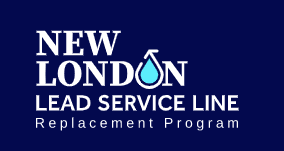

Potential Sources of Lead
Lead is a naturally occurring material used in many residential and industrial products, meaning we may be exposed to it at work or at home. Historically, lead was considered a good material for plumbing because it easily forms into different shapes and resists leaks.
For this reason, many homes may have lead-containing service lines to the house, pipes in the house, and kitchen and bath fixtures.
Lead may also be found in paint and other products, especially in older homes. See the illustration below for more information.
New London provides a source of drinking water that is routinely tested to verify it is safe. Additionally, New London water mains are not made of lead.
The service line consists of a portion owned by the customer and portion owned by the City. Either portion could be made of lead, wich could affect water quality inside a home.
Homes my contain lead piping and lead solder, which can affect drinking water quality.
Drinking water quality may be affected at the point of use if your plumbing fixtures and faucets contain lead.
Other potential sources of lead in a home include lead-based paint, dust, soil, jewelry and some plastics.
Simple Tips to reduce lead exposure in your home
Test your water...
if you are concerned about lead in your drinking water. Tests should be performed by a state certified laboratory. The cost for the test is between $10 and $50. A list of certified laboratories can be found in the document attached to this flyer.
Inspect your in-home water treatment devices...
and water softeners; they may increase lead levels in your water. Consult the manufacturer about how the device may affect your drinking water or plumbing. Avoid drinking softened water, as metals from your pipes are more likely to dissolve into soft water than in hard water
Filter your water.
Use a water filter that is NSF 53 certified for lead removal. Many filters and filter systems can improve water quality and taste in other ways too. Visit nsf.org for more information
Use cold tap water...
for drinking and preparing food. Hot water is more likely to contain lead than cold water.
Flush your tap for at least 5 minutes before drinking or cooking if the water in the faucet has gone unused for more than 6 hours.
However, the amount of time to run the water will depend on whether your home has a lead service line or not, and the length of the lead service line. If you have a known lead service line and your house is set far back from the curb, you may need to flush for longer than 5 minutes. After flushing, use the water for cooking or drinking, or save it for later use by filling pitchers. To conserve water, save the water from flushing the tap for watering plants or doing dishes.
Install lead-free faucets and fixtures...
that are certified to contain no lead. Look for lead certification marks indicating the new product is lead free, and then replace old faucets and fixtures. Visit nepis.epa.gov and search for lead free certification for more information.
Remove faucet aerators and flush...
cold water taps regularly. Aerators can collect particles from lead plumbing and should be removed and cleaned on a regular basis. It is especially important after household plumbing work and repairs. After removing the aerator, flush the cold water lines for 5 minutes.
More information and resources
New London Public Utilities (NLPU) is committed to providing a safe source of drinking water to its residents, and our staff work hard to keep that commitment. Because property owners in New London own a portion of their water service lines, there is a shared responsibility to manage lead exposure. We are ready to work with you to answer your questions about water quality and help reduce lead exposure.
NLPU offers the following additional state and national resources for you to learn more about lead and drinking water safety:
Lead Hotline – Contact the National Lead Information Center's hotline at 1 (800) 424-LEAD [5323]